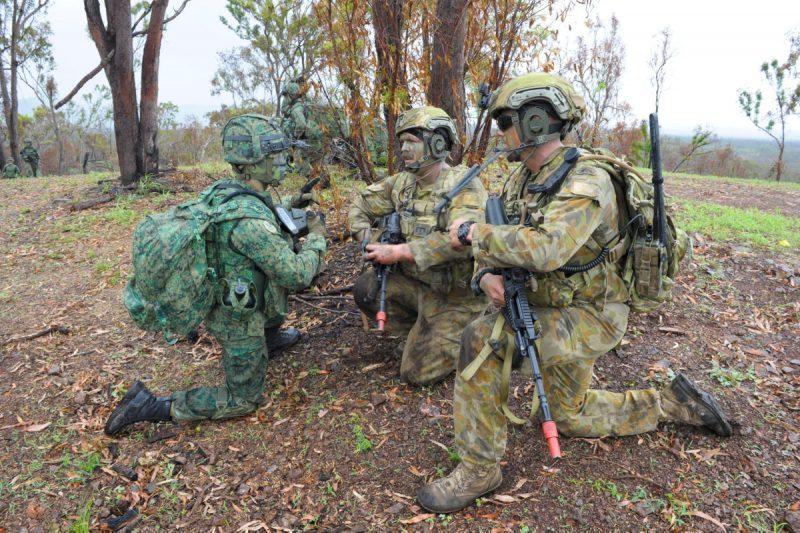
With Australia’s increasingly contested and uncertain strategic environment, defence diplomacy is more important than ever. The Australian Defence Force’s extensive and diverse training areas should play a key role in that effort.
The Australia–Singapore military training initiative and the US government’s force posture initiatives, including the Marine Rotational Force—Darwin, clearly demonstrate the value of our nation’s military training areas. However, the benefits of these agreements are by no means one way. While Singaporean and US forces come here to reap the benefits of our large training areas, Australia gains a high return on investment in terms of economic and strategic benefits and ADF interoperability.
The Singapore Armed Forces have been conducting individual and joint training in Australia since 1990, when the first Wallaby Exercise was held at Shoalwater Bay Training Area in central Queensland. These exercises have been growing in scale ever since.
In 2016, the Australian government announced that it had entered into a 25-year deal with Singapore under which the number of Singaporean troops training in Australia each year would increase to include as many as 14,000 personnel. These personnel will now stay in Australia for up to 18 weeks a year. The agreement also includes the co-development of a new training area in northern Queensland near Townsville. Singapore has pledged $2.65 billion to the project, which also includes an expansion of the Shoalwater Bay facility.
While it’s taken some time for the US Marine Corps to reach its target of training 2,500 marines in Darwin during the dry season, each of the US military services is cognisant of the benefits northern Australia’s training areas provide. The presence of the Marine Corps, and the accompanying Enhanced Air Cooperation initiative in Darwin, are important expressions of America’s strategic commitment to the security of the region.
To support the US Force Posture Initiatives, Australia and the US are investing around $2 billion in defence infrastructure and facilities at defence sites in the Northern Territory.
Even with the presence of the Marines and the SAF, we are yet to fully utilise northern Australia’s vast training areas, and their unique capabilities.
Earlier this year, our ASPI colleague Malcolm Davis highlighted the value of Delamere weapons range. But there are other training areas just waiting to be fully used. One of the most prominent and currently underutilised is the Bradshaw Field Training Area.
Bradshaw was established in 1996 on a former pastoral station near Timber Creek and the Victoria River in the northwest of the Northern Territory. Covering approximately 871,000 hectares, Bradshaw was initially acquired at a cost of $54 million to provide a training base for the 1st Brigade because the existing Mount Bundey Training Area was inadequate for manoeuvre exercises. Mount Bundey is limited in its capacity to handle some types of manoeuvre training, principally because of the impact of armoured vehicles on the environment and infrastructure.
In contrast with Mount Bundey, the Bradshaw Field Training Area is designed to support training in formation manoeuvres, field live-firing, and aerial live-firing and bombing. Its facilities include field firing areas, high explosive impact areas, manoeuvre areas, training sectors and infrastructure to support management and operational use.
Its remoteness also allows the ADF and its partners to use the full array of its electronic and cyber capabilities. It’s now part of the electronically networked North Australian Range Complex, which also includes the Delamere range and Mount Bundey.
Defence has already invested heavily in Bradshaw’s infrastructure, and it has promised more. With a road network of approximately 340 kilometres, maintenance areas, a range control facility, a 500-person campsite and support facilities, Bradshaw has become a turnkey capability that’s ready to go. Which is why it’s already regularly used by Australian, US and other forces (such as Singapore) for infantry and armoured formation manoeuvre and munitions training.
Of course, training at Bradshaw has its challenges. Northern Australia’s wet season makes year-round training, especially for land forces, particularly difficult. In addition to the practical mobility challenges of the wet, range users must be constantly mindful of their detrimental environmental impacts, which can get worse over time if they’re not careful. The Aboriginal heritage and cultural sites dotted across the training area also require careful management.
It’s clear that Bradshaw, like Delamere, is a critical defence asset. At present, however, the tempo of exercises by Australia, the US and Singapore at Bradshaw has plateaued, especially with the relocation of many of 1st Brigade’s armoured assets to Adelaide.
With the spare capacity in many of the north’s training areas, there’s plenty of opportunity to increase our defence diplomacy efforts by offering regional partners space to train.
Bradshaw, like other training areas in Australia’s north, has spare capacity that could be used by our Japanese, South Korean, Indonesian and Vietnamese defence partners.
As we continue to come to terms with our more dangerous and unpredictable strategic outlook, Australia’s defence diplomacy efforts should make use of these important assets to demonstrate our strategic commitment to cooperation in our region.